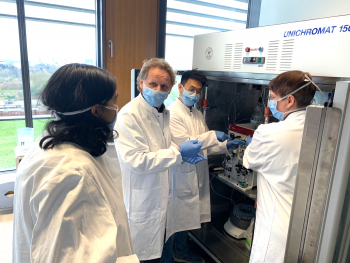29 Jul 2020 - Double-hit therapeutic strategy against COVID-19

The CoV-2 team: Rukmini Mukherjee, Ivan Đikić, Donghyuk Shin and Diana Grewe (left to right).
Molecular differences between SARS and SARS-CoV-2
Scientists from IBC2 and collaborating teams identified the papain-like protease (PLpro) of SARS-CoV-2 as an essential viral enzyme and potential weak spot. PLpro is required for the processing of viral polypeptides and the assembly of new viral particles within human cells. In addition, SARS-CoV-2 uses this enzyme to dampen the anti-viral immune response, helping the virus to modulate the host’s immune system to its own benefit. By this, the virus can easily multiply and spread further. The team has demonstrated that pharmaceutical targeting of PLpro by a non-covalent inhibitor (GRL-0617) blocks virus spread and increases anti-viral immunity in human epithelial cells, the prime site of pathogen entry. The respective results are now published in Nature.
“Our results offer the exciting possibility of a double-hit therapeutic strategy by targeting PLpro: stopping virus spread and empowering the human immune system at the same time”, explains IBC2 director Ivan Đikić, senior author on the manuscript. “To achieve this deep insight, we have combined biochemical, structural and functional expertise at our Institute, and I am incredibly thankful to the core team who has achieved a lot in a very short time. Our research alliance with the Institute of Medical Virology under the lead of Sandra Ciesek was of course the most critical to show how inhibition of PLpro stops the virus.“
Besides this, other scientists in Frankfurt, Munich, Mainz, Freiburg and Leiden have contributed with experimental data, reagents, and advice. We are indebted to our collaborators who have reacted immediately with their support. Donghyuk Shin, postdoctoral fellow and first author on this manuscript, comments: “Personally, I want to emphasize the power of science and the greatness that collaborative culture can produce. By seeing our results all together, I was really grateful for being a scientist.”
These results deliver the full scientific rationale for pursuing further clinical investigations with compounds or drugs targeting PLpro of SARS-CoV-2.